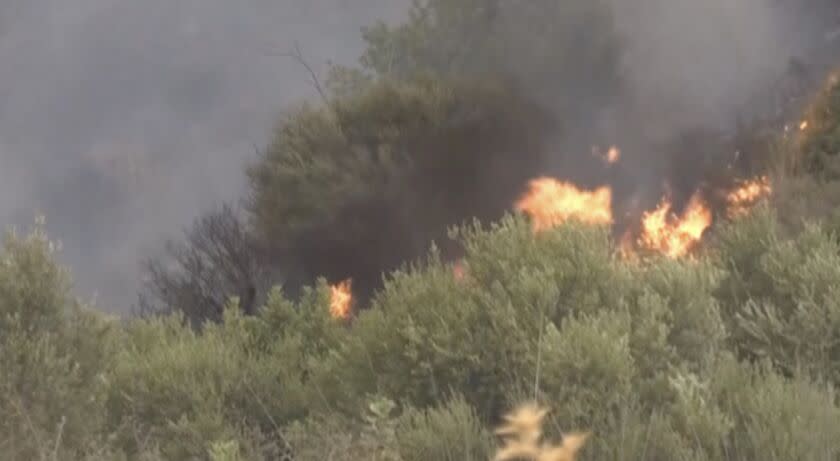Opinion: How wildfires in Algeria and California reveal colonial origins of the 'Mediterranean climate'

More than 30 people have died in the under-reported wildfires in Algeria, while blazes in Greece and Italy have made headlines. Top concerns in these disasters have been the future of tourism.
All of these countries are considered to have a so-called Mediterranean climate, as does California. But, are they all the same in their Mediterraneanness?
A Mediterranean climate has been identified in Chile, Australia, South Africa, California and, of course, around the Mediterranean. Characterized by cool wet winters, hot dry summers and endemic plants that thrive under such conditions, they are considered among the most endangered ecosystems on the planet due to their restricted geographical area. Interestingly, most environmentalists and scientists seem to be concerned about forest fires in these regions, not about the scrubby plants that predominate the coastal areas and that tend to be the ones most endangered, not even so much by fire, but by urban encroachment.
Read more: Op-Ed: Wildfires have changed. Firefighting hasn't
It’s time now, though, we recognize that Algerian landscapes, like those of California, are colonial ones. These landscapes were transformed to fit an European idea of Mediterranean-ness. The consequences of this misunderstanding of natural ecosystems as preserved by Indigenous peoples, and of the damage inflicted in these regions are now evident in the wildfires in North Africa.
Although 90% of Algeria is made up of the Sahara Desert, French colonialists believed the country was once lushly forested. The French imposed laws to criminalize the use of forest fires (which are an integral part of the ecosystem) and to forbid the traditional multiple uses of the forest by Indigenous people. Likewise, in California, forest fires were also suppressed and Indigenous inhabitants removed.
In Algeria, in the early 20th century, the French started planting eucalyptus, which are highly flammable, as a timber source. The French Forest Code was derived mostly from tropical islands and brought to its North African colonies. In California, the suppression of forest fires was an intrinsic part of remaking the forest and rejecting all traditional Indigenous practices.
Despite poor success in afforestation in Algeria, the notion that the country should be forested was undeterred, persisting to the present. The 1960s Algerian Green Dam project was initiated to plant trees to stop the northward advancement of the Sahara, under the misapprehension that the Sahara was growing north. Flammable Aleppo pine was planted. Pine caterpillar invasions devastated the trees, and humans contributed to deforestation. Still, this effort continues to be funded by the African Union, the World Bank and the European Union, part of a larger project of a green band of trees and vegetation across the entire length of the Sahara that will likely fail.
In California, forest practices that suppressed naturally occurring fires and traditionally set fires have resulted in dense, overgrown forests, where trees compete for light and water, are more susceptible to disease and of course, even more at risk for extreme fire. The state’s recent megafires show the result of this management, exacerbated by a hotter, drier climate.
Diana K. Davis, a professor of history at UC Davis, has suggested in her book “The Arid Lands” that the Middle East is part of a dryland complex, including North Africa, raising the question of whether Algeria has a Mediterranean climate at all but instead its own semi-arid ecological condition.
If so, then perhaps investing in protecting and reviving the various systems of precolonial practices and land uses might make more sense than planting trees. Instead of homogenizing areas across the world into equivalents, paying attention to difference and specificity might produce land management that is not so prone to fire, and might also help make those landscapes healthier.
Read more: Opinion: Climate change is worsening the world's refugee crisis. Here's one way leaders can help
California’s landscapes too could be less fire-prone if urbanization in terrain at high risk were curtailed and fires reintroduced into its forests in a systematic way. By classifying landscapes and regions by type — Mediterranean being one such type — Western European science and values have distorted Indigenous landscapes so that they have become far more susceptible to climate change and fire. The assumption that these lands are all the same means that ideas of their management transfer across borders to great damage.
Algeria is a desert-dominated, semi-arid place where development policies and urbanization practices have put people in altered landscapes at great risk of fire. California too has suffered from a scientific approach that overlooked its ecology and the ways in which people lived here in the landscapes. Fire, disaster and death are likely to continue until we reckon with this colonial legacy.
Stephanie Pincetl is a professor at the UCLA Institute of the Environment and Sustainability. She conducts research on California land use, energy and water.
This story originally appeared in Los Angeles Times.

